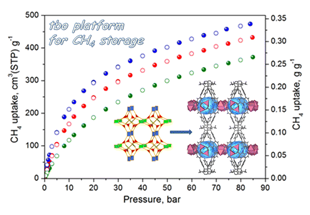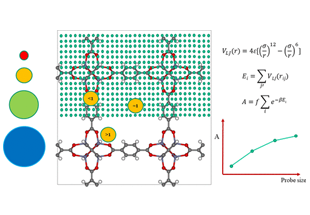Search
CLOSEDesign of multifunctional open framework materials
Dr. Emmanuel Klontzas
Computer-aided design of carbon-based nanomaterials and hybrid open framework structures
- Modeling of Carbon-based nanoporous materials and nanostructures
- Design of multifunctional open framework materials
Open Framework Materials constitute a continuously growing class of porous crystalline materials that has attracted a lot of attention in the past few years. The two most known subcategories of this class are Metal-Organic Frameworks (MOFs) and Covalent-Organic Frameworks (COFs), which are further divided to smaller groups. MOFs are a class of hybrid porous materials that combine chemically bonded inorganic nodes containing metal centers and organic linker moieties, leading to the creation of a crystalline solid with well-defined pore structure. The large variety of inorganic nodes and organic linkers can provide porous materials with various topologies and tailor-made properties. Moreover, their chemical properties can be adjusted by the presence of functional groups in their pores, grafted on certain positions on the organic linkers. Open Framework materials have been considered as extremely promising materials for a large variety of applications, including gas storage and separation related to energy and environmental applications. Our research activity in these areas consider the design of Open Framework materials with enhanced hydrogen and methane storage capacities and the selective capture of gases with significant environmental impact such as carbon dioxide, hydrogen sulfide and fluorinated gases. Moreover, we have extended our research methodology in designing functionalized MOFs which will be able to selectively capture organic and inorganic pollutants by tailoring the host-guest interactions.
Key Publications

Reticular Synthesis of HKUST-like tbo-MOFs with Enhanced CH4 Storage

A Robust Machine Learning Algorithm for the Prediction of Methane Adsorption in Nanoporous Materials

Reticular Chemistry and the Discovery of a New Family of Rare Earth (4, 8)-Connected Metal-Organic Frameworks with csq Topology Based on RE4(μ3-O)2(COO)8 Clusters

Enhancement of CO2 Adsorption in Magnesium Alkoxide IRMOF-10
Computer-aided design of carbon-based nanomaterials and hybrid open framework structures
- Modeling of Carbon-based nanoporous materials and nanostructures
- Design of multifunctional open framework materials
